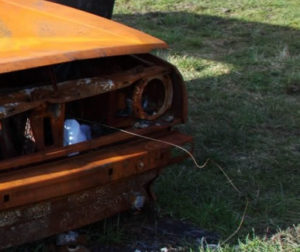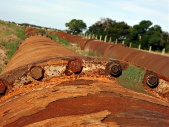The Annual Cost of Vehicle Corrosion
 When you think about motor vehicle corrosion, you may picture an old rusted-out “beater” from the 1970s. Thanks to major improvements in manufacturing and prevention, visible corrosion isn’t as much of a problem for today’s cars, but corrosion does still cause serious damage to motor vehicles every year.
When you think about motor vehicle corrosion, you may picture an old rusted-out “beater” from the 1970s. Thanks to major improvements in manufacturing and prevention, visible corrosion isn’t as much of a problem for today’s cars, but corrosion does still cause serious damage to motor vehicles every year.
Corrosion causes a whole host of problems in motor vehicles, from unsightly rust on the body panels to the wearing out of electrical components, all the way up to sudden brake failures that can result in serious accidents.
The harmful effects of corrosion on motor vehicles cost billions of dollars every year. In fact, according to a 2013 study by NACE International, the total cost of corrosion in all industries worldwide is estimated at approximately $2.5 trillion. That’s almost 3.5% of the entire world’s GDP!
In the United States, corrosion in all industries, including infrastructure, utilities, and manufacturing as well as transportation, costs approximately $276 billion per year, according to a study commissioned by the U.S. Federal Highway Administration (FHWA).
Additionally, the U.S. Department of Defense had a study performed in 2011 on the cost of corrosion for Army ground vehicles. That study found corrosion was costing the Army about $1.6 billion annually, which was over 12% of the total amount that the Army spent on maintenance for those vehicles.
Obviously, corrosion is a serious and expensive problem. Let’s take a look at why that is and exactly how much motor vehicle corrosion actually costs us per year.
What is Corrosion?
The FHWA describes corrosion as “a naturally occurring phenomenon commonly defined as the deterioration of a substance (usually a metal) or its properties because of a reaction with its environment.”
In other words, corrosion is the rusting or breakdown of materials caused by exposure to outside substances like water, salt, de-icing solutions, acid rain, and other chemicals. One of the biggest causes of corrosion for motor vehicles is the salting of roads in the winter, but cars driven in warmer climates suffer damage from corrosion too.
Damage from Corrosion
Corrosion damages motor vehicles in several different ways, which can be both costly and dangerous. For instance, in 2011, the U.S. National Highway Traffic and Safety Administration (NHTSA) began an investigation due to reports of mysterious and sudden brake failures that had caused over 100 crashes.
What the NHTSA ultimately found was that the failures weren’t caused by any defect in the manufacturing of the cars. Instead, the sudden brake failures were caused by corrosion of the brake lines due to long-term exposure to salt and other de-icing chemicals.
Another example of corrosion damage that’s less dangerous than brake failure but still a potential hazard: In 2014, Toyota Canada recalled nearly 100,000 minivans due to a corrosion problem. The design of the minivan allowed water from the roadway to splash up where the spare tire was connected to the vehicle.
The salt brine from the de-iced roads corroded the metal holding the spare tire in place. As a result, the spare tires were falling off of the minivans!
Other components of motor vehicles that are particularly susceptible to corrosion include the exhaust system, the radiator, the frame, and the suspension. But electrical components, fuel tanks, and other parts can be damaged as well.
The Costs of Corrosion
Several estimates have been made of the costs of corrosion for motor vehicle owners. As the 2002 FHWA report explains, these costs include not only the cost of repairs, but also the increased cost of manufacturing vehicles that are corrosion-resistant and the depreciation of the vehicles due to corrosion damage.
For instance, in 2016, the non-profit advocacy organization AAA performed a survey looking at the cost of repairing damage due to corrosion. What they found was that U.S. automobile owners had spent approximately $15.4 billion over the previous five years to repair rust damage caused by de-icing salts and chemicals.
That’s an annual cost of about $3 billion just to repair corrosion from de-icing. The Transportation Research Board estimates that about half of corrosion damage is caused by de-icing, while the rest is caused by other culprits such as acid rain and marine environments. That suggests the total annual cost of corrosion-related repairs might be closer to $6 billion.
In fact, the 2002 FHWA report estimated the annual cost of all corrosion-related motor vehicle repairs right at $6.45 billion.
The 2002 FHWA report didn’t just look at the cost of repairs—they also studied the broader range of the costs related to corrosion. After consulting with automobile manufacturers, they estimated the increased cost of manufacturing corrosion-resistant cars at about $150 per new vehicle. That worked out to $2.5 billion per year as of 2002.
Furthermore, the FHWA estimated the cost of corrosion-related depreciation in higher and lower-corrosion areas in the 1990s. They found that corrosion reduced the value of cars in the higher-corrosion areas by about $140 per year and in lower-corrosion areas by about $110 per year.
Of course, due to inflation, those numbers are probably higher today. Overall, the FHWA found that corrosion-related depreciation costs about $14.4 billion per year.
Ultimately, the FHWA report estimated the total cost of motor vehicle corrosion at $23.4 billion annually. Given that there were approximately 200 million motor vehicles on the roads in the U.S. at the time of the report, the cost of corrosion comes out to an average of $117 per vehicle every year.
